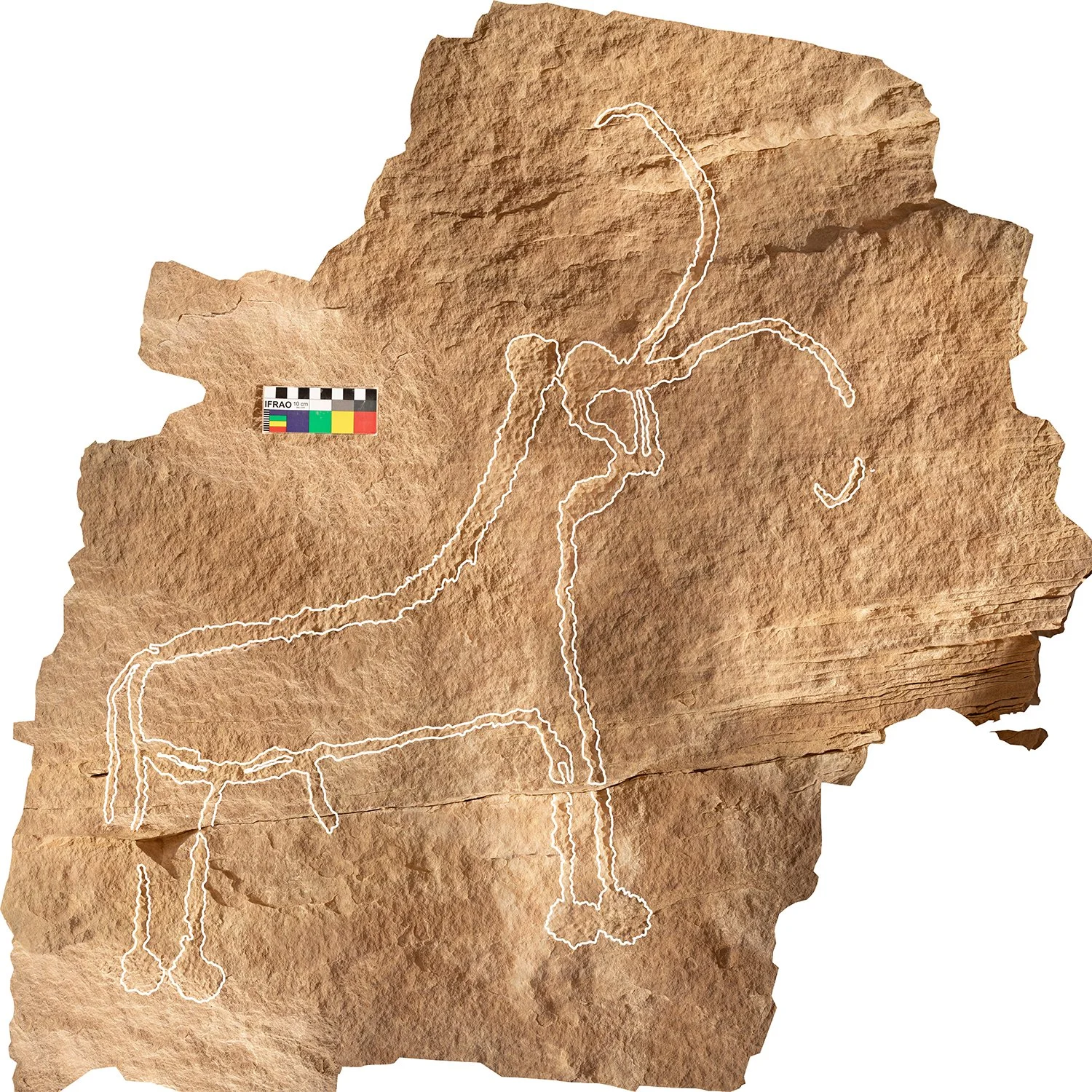Dispatch from the Field: Sailing into the Desert
Salutations from Somers Clarke House! One of the things that the gods bestowed upon the ancient Egyptians was the “sweet north wind” (tjau nedjem ni mehyt—the hieroglyphs written above). The gods must be smiling on our expedition, as that wonderfully sweet breeze came yesterday, and 105° felt like 75° (the humidity in the desert is typically around 10%). The north wind is important for another reason: since the Nile flows north, the prevailing wind from the northwest enabled ships to sail against the current. Egypt is certainly blessed by an ideal combination of natural phenomena!
In Predynastic rock art, ships also seem to sail out into the desert. At the site that I described in my last dispatch, at the juncture of the east-west wadi (Wadi Abbad) and a northeast-southwest wadi (Wadi Shaghab), is a rock art panel with a large boat, two men, and a donkey. An unusual combination, right? Additional human figures are below, and all of the men wear one or two ostrich feathers in their hair, a style seen throughout the Predynastic Period, especially among desert groups. The rightmost man in the boat is holding a small bow, and in rock art of this date, the donkeys are wild asses, not the domesticated equid that has spent seven thousand years transporting people’s stuff—waterskins and wine jars; grain and vegetables; and people themselves (although no ancient Egyptian is ever shown riding a donkey, only foreigners).
Photograph of boat panel rock art
The people who carved this rock art panel about five thousand three hundred years ago used a technique called pecking or percussion. Even today, you can see that the carving is a lighter color than the surrounding rock. We call the outer crust the rock’s patina, and by removing that patina, the much lighter part of the stone underneath is exposed. When this—and pretty much all rock art—was carved, it would have stood out prominently, even at a distance. For example, the el-Khawy early hieroglyph inscription is still visible from the road today—and when it was first pecked and incised no one traveling below the inscription could have missed it.
Pecking rock art detail
So why carve boats in the desert? John has developed a model that explains this phenomenon, which is widespread in rock art both east and west of the Nile Vally: “Niloticizing the desert.” In “Iconographic Attraction, Iconographic Syntax, and Tableaux of Royal Riutal Power in the Pre- and Proto-Dynastic Inscriptions of the Theban Western Desert, Archéo-Nil 19 (2009), John notes:
“Desert animals may not only appear alongside Nilotic scenes, but desert animals and Nilotic animals may mingle near boats, and desert game may be hunted directly from boats. … Employing Nilotic imagery at desert sites and consciously combining riverine and desert motifs within a single image or grouping of images allowed for a Niloticization of the desert, an incorporation of the desert margins into the ever more complex cultures of the Nile Valley. … The rock art in which symbols of desert and Nile interact and in which Nilotic imagery interacts with the desert surfaces, create a liminal singularity in the desert, and an evocation of the one time each year when the Nile could indeed touch the gebel in many portions of the Nile Valley—the Inundation.”
You can read the full article here (some of the material is also covered in the book I mentioned in my last dispatch, John’s 2021 monograph Egypt and the Desert).
Elephant rock art detail
Another rock inscription at the same site depicts a large elephant, which a visitor carved over five thousand five hundred years ago. I did this drawing with an orthoimage of a 3D model that was exported onto an iPad, a technique for recorded rock art developed by John, Alberto Urcia, Sara Zaia, and myself—read about it here).
Were there elephant herds roaming what is now the desert? No! While the final desiccation of the Sahara Desert occurred about 2500 BCE, the last time this area was a savanna was closer to 10,000 years ago. The ancient artist conjured a mental image of an pachyderm and then pecked it into the rock. Based on other images of elephants in Predynastic rock art, the elephants and other “megafauna”—such as bulls and giraffes—were animals that expressed power.
Marking place and communicating across time, these images and texts are some of the best evidence we have for what these people were thinking when they carved on the rocks. They were not at that spot seeing either boats or elephants! Prior to the invention of hieroglyphs, these images symbolically encapsulated their beliefs about their world and the cosmos . Stay tuned for my next dispatch about our exciting conservation work at Somers Clarke House.
Sincerely, Colleen





